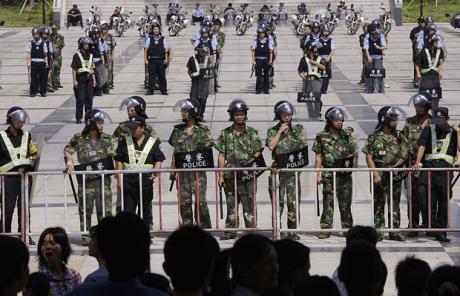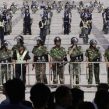
CCPLA: Tightening the CCP’s Rule over Law
Publication: China Brief Volume: 9 Issue: 7

Beijing is beefing up its control apparatus to counter unprecedented challenges to the Chinese Communist Party (CCP) administration this year. Apart from on-going protests in the Greater Tibet Region, the police, state security, People’s Armed Police (PAP) and other units are bracing themselves against demonstrations, riots—and other “mass incidents” by tens of millions of unemployed workers and farmers. With the 20th anniversary of the Tiananmen Square crackdown just two months away, the leadership under President Hu Jintao and Premier Wen Jiabao is also devoting more resources to monitoring the activities of dissident intellectuals—including those based in the United States. The Central Commission on Political and Legal Affairs (CCPLA), China’s highest-level law-enforcement agency, is masterminding multi-pronged tactics to ensure that the CCP’s mandate of heaven will not be torn asunder by destabilizing agents on disparate fronts.
In his Government Work Report to the National People’s Congress (NPC) in March, Premier Wen underscored the imperative of the “three guarantees”: 1) guaranteeing economic growth, 2) the people’s livelihood and 3) socio-political stability. Of these three goals, combating anti-government and other hostile forces could become the most difficult. According to CCPLA Secretary and Politburo Standing Committee member Zhou Yongkang, police, judicial and other law-and-order departments must “seriously pre-empt [troublemakers] and aggressively tackle them so as to guarantee national security.” Zhou added that more attention should be paid to improving intelligence gathering, strengthening Beijing’s ability to handle emergencies, and, in particular, “boosting the construction of professional [law-enforcement] forces” (People’s Daily, March 6; Xinhua News Agency, February 1).
More responsibility than ever will be put on the traditional “tools of the democratic proletarian dictatorship,” the People’s Liberation Army (PLA), the PAP and the police. Even though the main task of China’s 2.4 million-strong soldiers is to protect the country against attacks by hostile foreign forces, the CCP leadership has been augmenting the PLA’s role in upholding domestic law and order. While announcing the 14.9 percent budget boost for the PLA this year, NPC spokesman and former Foreign Minister Li Zhaoxing noted that the increased outlays would partly go toward “safeguarding [socio-political] stability and other non-warfare military operations.” This suggested that while fighting destabilizing elements at home is basically the job of the PAP, more soldiers than ever are directly involved in the party’s domestic agenda. For example, several tens of thousands of PLA and PAP officers were deployed to Tibet in the first two months of the year. Their principal job is to prevent Tibetans from holding protests and other disruptive actions to mark the 50th anniversary of the failed Tibetan Insurrection in March 1959 (Straits Times [Singapore], March 9; Ming Pao [Hong Kong], March 10).
The PAP’s role in preserving law and order and hitting out at “anti-party elements” has been enhanced. In his Government Work Report, Premier Wen indicated that Beijing would “boost the construction of PAP units, increase the frequency of deployment, and ramp up their ability to handle emergency events, to fight terrorism and to safeguard social stability.” For the first time, PAP Commander Wu Shuangzhan was made a member of the CCPLA earlier this year. Previously, CCPLA members only comprised cadres from the police and state security departments as well as representatives from the courts and the procuratorates. Since January this year, provincial PAP officers have also been inducted into regional-level Committees on Politics and Legal Affairs (Southern Metropolitan News [Guangdong], March 21; Sina.com.cn, March 22; People’s Daily, March 6).
After the series of riots and disturbances in Tibet in March last year, Beijing unleashed a so-called “people’s warfare” against ethnic “splittists” (China Brief, July 17, 2008). The scale of mobilization was enhanced in the run-up to the Summer Olympic Games. In addition to regular police and PAP units, PLA reservists, myriad vigilante groups as well as neighborhood committees were asked to patrol the streets and report suspicious characters or bomb-like objects to the authorities. In the eight weeks prior to the August Games, about 1 million Beijing residents participated in security-related tasks (Asian Wall Street Journal, August 22, 2008; Asia Times Online [Hong Kong], April 30, 2008). There are indications that the CCPLA and other law-enforcement agencies have turned this tradition into a permanent institution. The Beijing media has reported that at least 600,000 residents in the capital took part in largely voluntary duties to improve safety during the annual sessions of the NPC and the Chinese People’s Political Consultative Conference held last month. Personnel involved included vigilante groups, neighborhood committees, as well as security officials employed by enterprises (Beijing Evening Post, March 1; Ming Pao, March 2).
Public security departments in major cities ranging from Shanghai to Guangzhou have also speeded up the installation of surveillance cameras, CCTV and other equipment in places such as airports, railway stations, bus-stops and busy intersections in urban areas. Guangdong authorities indicated earlier this year that 1 million surveillance cameras would be established throughout the Pearl River Delta (PRD) region by the end of the year. Due to the upsurge of unemployment in the export-dependent PRD area, Guangdong Police have asked enterprises there to improve security work regarding human resources, facilities and technology. Thus, factories are told to hire sufficient internal security officials, to ensure that doors, gates, fences and locks are in good shape; and to set up sufficient alarms and surveillance cameras. A clear sign of Beijing’s worry of the instability that may come, the Guangdong Nanshan branch of the Public Security Bureau formed a group of urban administrative enforcement teams comprising of 1000 policemen, district security guards and militia (Guangdong Province Public Security Net, March 9; Ming Pao, February 14; Nanfang Daily, March 28).
At the same time, the politicization of China’s courts has been exacerbated by Chief Judge Wang Shengjun’s call for the judiciary to sub-serve the CCP leadership’s goals of “ensuring economic growth, ensuring the people’s livelihood, and ensuring stability.” In a series of speeches last month, Wang, whose official title is president of the Supreme People’s Court, demanded that the nation’s judges and judicial cadres “attach more importance to [the principle of] party leadership, and to self-consciously accepting supervision [by party authorities].” A former secretary-general of the CCPLA, Wang noted that the courts must “pay more attention to the social effect of adjudication work.” He added that the judiciary must as far as possible “defuse contradictions” among socio-economic sectors that had been hard hit by the global financial crisis (Xinhua News Agency, March 17; People’s Daily, March 24).
Moreover, CCP authorities have to some extent revived the 1980s-vintage practice of turning demobilized soldiers and police officers into judges and prosecutors. In a recent speech, CCPLA Secretary Zhou indicated that special measures should be taken to solve the problem of the lack of judicial officials particularly in the hinterland regions. Zhou instructed a number of law schools to select demobilized PLA and PAP officers who have high-school diplomas for fast-track training so that they can soon serve as judges and prosecutors in the central and western provinces (Xinhua News Agency, February 1; Qiushi [Beijing journal], February 1).
Are the sharpened “tools of proletarian dictatorship” working properly? At least on the surface, the situation in the Greater Tibet Region seems more stable than what it was a year ago. For more than a month last year, tens of thousands of Tibetans staged protests in the Tibet Autonomous Region (TAR) and neighboring provinces with large concentrations of Tibetans such as Qinghai, Ningxia and Sichuan (China Brief, September 3, 2008). In the past month, while several incidents such as attacks on police stations in Qinghai have been reported, the PAP and police seem to have acquitted themselves well. Over the longer term, however, Beijing’s putative goal of seeking reconciliation with Tibetans seems illusory. At a ceremony marking the region’s first Serfs’ Emancipation Day the hard-line TAR Party Secretary Zhang Qingli resorted to the same harsh rhetoric as before. “Our struggle with the Dalai Lama Clique does not involve questions of nationalities, religion, or human rights,” he said. “It is a struggle regarding the maintenance of national sovereignty and territorial integrity.” What Zhang did not mention, however, was that most monasteries in Tibet were tightly controlled by police officers who were stationed there on a 24-hour basis (Xinhua News Agency, March 28; New York Times, March 14).
Yet another weak link of China’s labyrinthine control mechanism is the fast-deteriorating quality of the police and other law-enforcement agencies, especially those at grassroots levels. Quite a number of relatively minor incidents have developed into law-and-order disasters because of the incompetence—and corruption—of police. Take the mishap in the township of Dongfang, Hainan Island in late March, in which residents from two different villages battled each other for three days in addition to attacking local public security bureaus. The rioting was precipitated when a teenager from one village was beaten up by schoolmates from another village. The latest edition of the official Outlook Weekly news magazine quoted Hainan residents as saying that they had lost trust in law-enforcement officials “because they are corrupt and they offer protection to criminals.” Earlier this year, 3,000 heads of grassroots-level police stations had received legal and political training in Beijing on ways and means “to uphold the law in a rational and stable manner—and without using excessive force.” Apparently, the new spirit of civilized law enforcement has yet to percolate to different corners of the nation (China News Service, March 30; Outlook Weekly [Beijing], March 29; People’s Daily, February 27).
Likewise, poor standards and graft-related offenses among judges and prosecutors have dented the ability of the courts and procuratorates to fulfill the vital function of “defusing contradictions within the people.” Investigations into the corruption of the former vice-president of the Supreme People’s Court, Huang Songyou—the most senior judge to have been incarcerated in recent memory—have dragged on for more than six months. Things now are such that the SPC recently publicized a dozen-odd telephone numbers, which citizens could call to blow the whistle on particularly venal and incompetent judicial cadres (People’s Courts News [Beijing], January 19; China News Service, March 11; Ming Pao, March 12). Unless the Hu-Wen leadership is able to ameliorate the dubious qualities of its assorted tools of socio-political control, the indiscriminate application of heavy-handed tactics to snuff out dissent and other challenges to CCP suzerainty could backfire badly.





